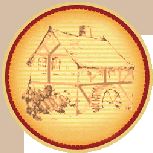by Les Saidel - October, 2014
As autumn approaches and the sweltering heat of the summer gives way to cooler, breezier weather I would like to take this opportunity of discussing the subjects of drafts (cold winds) and draughts (liquid beverages). To make the topic a little more interesting, I will explore their effects both on the human organism and on bread baking.
Let's begin with drafts, or cold winds. Common wisdom has suggested that being exposed to cold drafts will give you a "cold" or even influenza. This has been dispelled by much research since the 1950's that indicates that the contraction of a cold is not caused by temperature variations, but rather by increased incidence of being "cooped up" indoors with other people, thus increasing our exposure to the various viruses which are omnipresent in the air, in our respiratory tracts and those of others, waiting to strike at the opportune moment.
A recent study at the Cardiff University in the UK however, seems to prove otherwise. Using two control groups, one with their feet in icy water for extended periods of time and the other staying warm and dry, it was found that the group with "cold feet" had a significantly higher susceptibility to common cold symptoms of sore throat and runny nose.
The most prevalent consensus amongst the experts at the present time now seems to be that colds or influenza are ultimately caused by viruses, which are present in the environment throughout the year, not just in the winter. They exist in the air that we breathe and are thus also present in our respiratory tracts. There they are eliminated by the various components of our immune systems which deactivate them and render them harmless. If however our immune systems are compromised or weakened, the virus, which is constantly hammering away, very much like a woodpecker at a tree, will find an opening and cause infection.
According to this latest study, extreme cold, like sitting with your feet in a bucket of ice water, or even a cold draft as you get out of the shower is all that it takes in some individuals, whose immunity may not be in the best shape anyhow, to lower their guard, even for a second or two, enough for the virus to infiltrate and do its damage.
Therefore, the old-wives wisdom of wrapping up, keeping warm and avoiding drafts may not be such bad advice after all. The cold weather may not be the direct cause of the infection, but may certainly facilitate it.
Interestingly enough, rising dough and even baked bread, react as poorly to cool drafts as do humans.
Rising dough dislikes any kind of wind blowing on it, hot or cold. The draft dries out the outer crust of the dough, preventing it from rising freely and creating a dry outer skin that, when mixed back into the dough after punching down, interferes with the texture of the bread. If the draft is also cold, it will lower the temperature of the rising dough, hindering the yeast reproduction and slowing the rise. While in certain cases this effect is desirable - in professional baking lingo it even has a terminology: retardation - in most home baking settings it is not welcome.
The old fashioned baking tradition of leaving the dough to rise in a warm place, covered, was intended to address these very problems.
Baked bread also dislikes drafts, especially cold ones, which accelerate the staling process. Bread stales quickest at around 4 degrees celcius (which is also why it is a bad idea to store bread in the fridge). Bread will keep fresh longer covered, either in paper or plastic bags in a warmer place (not too warm or it may encourage mold growth).
From the above, it appears that drafts are persona non grata both for people and bread in its various stages.
If drafts are the malady, then draughts are the cure! By draughts, I am referring to liquid beverages of various types and forms.
Old-wives wisdom dictates that in cold weather one should dress up warmly and drink warm drinks. Perhaps the most famous and debated hot beverage or draught is chicken soup, or what has been termed "Jewish penicillin".
In a study conducted in the University of Nebraska Medical Center in Omaha it was found that migrating white blood cells, which stimulate the production of mucous, travel less freely in the presence of chicken soup. The theory is that some ingredient, or combination of ingredients (they have not yet isolated which) in the soup blocks or slows the migration of cells to the lung area, thus relieving the traditional cold symptom of congestion.
Other medical practitioners say that chicken soup's effects on the common cold are purely psychosomatic, while even others claim that the soup provides the necessary hydration to flush out the virus, but could just as well be a hot cup of tea.
Although the relief of cold symptoms may seem desirable, it must be remembered that congestion is the body's natural reaction to infection and to self healing. By retarding the body's natural defense and recovery mechanism, with chicken soup, or any other decongenstant medication for that matter, one may be temporarily relieving the symptoms, but prolonging the total recovery time.
So while it is debatable whether any hot draught of beverage has "antibiotic" properties, another property of warm or hot draughts is undisputed - it raises core body temperature.
This links back to the previous discussion of cold drafts and the effect of cold temperatures on the resilience of the immune system. By stocking up on a warm drink and thus raising body temperature, one may offset the effects of exterior cold's effect on the body. One should therefore liberally drink hot beverages during the cold season, especially just before setting off outdoors into the freezing cold.
Some may think that other beverages such as alcohol will have the same effect - the Russians in Siberia drink vodka to keep warm don't they? This is a myth and actually potentially dangerous, because not only does alcohol not warm up your body (it just gives the illusion that it is), but it in fact lowers your body's core temperature, making you more susceptible to the cold. In addition, alcohol inhibits the body's tendency to shiver - a self preservation mechanism used to warm up the core body temperature.
So chicken soup, hot tea, coffee and hot chocolate - YES, alcohol - NO!
While warm or hot draughts are an excellent way of regulating the human body's core temperature, they are also the most effective way of manipulating the performance of bread dough.
You will undoubtedly have noticed the difference in baking in summer and in winter. In summer the dough rises quickly due to the ambient heat, while in winter it reacts sluggishly. The factor that determines the speed or sluggishness of dough rising is the yeast and its rate of reproduction. The more yeast cells present, the more carbon dioxide gas released in the chemical reaction as the yeast cells digest the glucose present when the starch in the flour is broken down.
Yeast, like humans, prefers a warm environment and habitat to feel most comfortable. In fact yeast reproduces most effectively in the range of 27-30 degrees celcius. If your dough temperature is in that range it will rise well.
In winter, mixing the dough with tap water, which is significantly lower than 27 degrees C, will cause your dough to rise sluggishly. By raising the temperature of the water, you may easily affect the dough temperature.
There is a scientific formula for determining the exact temperature the water should be in order that the final dough will have a temperature of 27 degrees, I will not bore you with it here. It is much simpler and user friendly to follow this rule of thumb. In winter the water added to the dough should be hot, not luke warm. How hot? Hot enough that when you insert your hand in it, it does not burn or scald you. If you get scalded by the water, the yeast cells will also be killed by that water and you have defeated the purpose. The temperature of the water for your dough should be about the same as you would use when you run a hot bath for yourself.
Using luke warm water is OK in summer, but in winter it is not sufficient because it needs to counterbalance the temperature of the other ingredients, such as flour, sugar etc. which are all at room temperature, which is much colder in winter than in summer. Therefore an extra boost of heat is needed in the water for mixing the dough in winter.
There you have it! The similarities in behaviour of the human body and bread dough are not coincidental. We tend to forget that bread dough is alive! It is a living, breathing, living entity (albeit not on the same rung of the food chain as humans), and shares some of the basic necessities and preferences for climate and environment as we do.
Winter is the perfect time for home baking. We need the extra carbohydrates in winter, which is why people tend to eat more baked products in the cold season than in summer. It is also more psychologically conducive to baking - congregating around a snug, warm kitchen and oven in winter (as opposed to wanting to dive into the pool in summer).
So revel in your winter baking, enjoy the feeling of warmth and togetherness and using some of the tips above, keep yourselves healthy and your bread baking performing flawlessly.
Les Saidel
© Copyright. All rights in the above articles are reserved to the author Les Saidel.
No part of this website or the above articles may be transmitted in any form or by any
means without permission in writing from the author.




